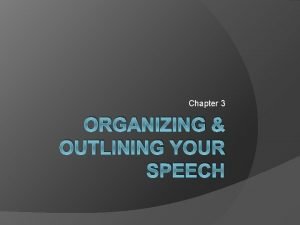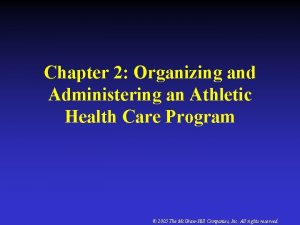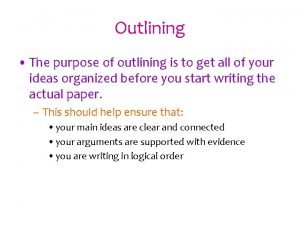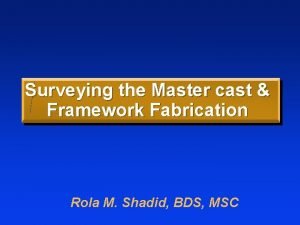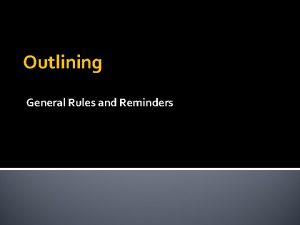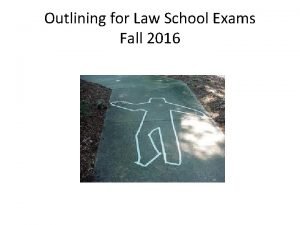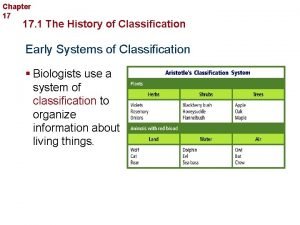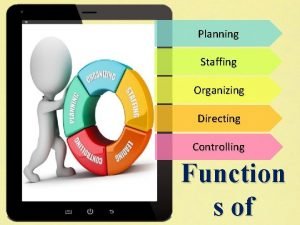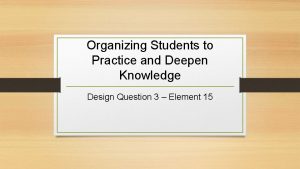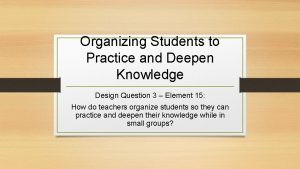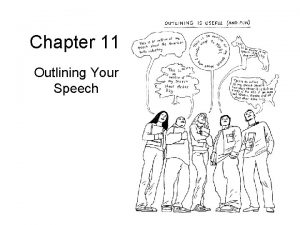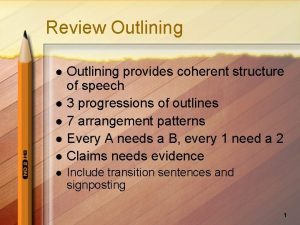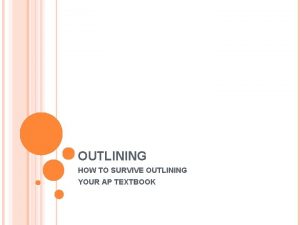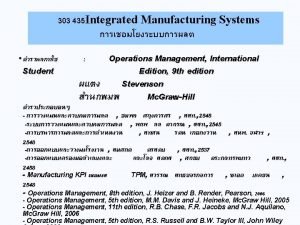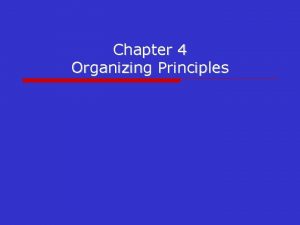Organizing and Outlining Chapter 6 of T Rice






















- Slides: 22

Organizing and Outlining Chapter 6 of T. Rice (2017) Fundamentals of Public Speaking Chapter by Joshua T. Barnett

What is involved in Organizing and Outlining? • • • Select topic Formulate purpose Thesis statement Arrange main points Connect points Create outline

Questions to Help Select Topic • • What important events are occurring locally, nationally and internationally? • • • What do I care about most? • Is there someone or something I can advocate for? • What makes me angry/happy? • What beliefs/attitudes do I want to share? • Is there some information the audience needs to know?

Formulating a Purpose Statement • The general purpose statement of a speech may be to inform, to persuade, to inspire, to celebrate, to mourn, or to entertain. • Then frame a specific purpose statement around one of these goals. • In short, the general purpose statement lays out the broader goal of the speech while the specific purpose statement describes precisely what the speech is intended to do.

Writing the Thesis Statement • Convert the specific purpose statement into a central idea, or thesis statement that you will share with your audience • A thesis statement may encapsulate the main points of a speech in just a sentence or two, and be designed to give audiences a quick preview of what the entire speech will be about. • A preview statement (or series of statements) is a guide to your speech. This is the part of the speech that literally tells the audience exactly what main points you will cover.

Writing the Main Body of Your Speech • The body of your speech is the opportunity for you to elaborate on facts, evidence, examples, and opinions that support your thesis statement and do the work you have outlined in the specific purpose statement. • You must decide which elements to include and how they ought to be organized to best suit your purpose. • Arranging your ideas (1) chronological or temporal, topical, spatial, or causal patterns (better suited to informative speeches), or (2) problemsolution, Monroe’s Motivated Sequence, Claim-to-Proof, or refutation pattern (best for persuasive speeches).

Arrangement: Chronological • Main points delivered according to when they happened • Helpful when describing historical events to an audience as well as when the order of events is necessary to understand what you wish to convey.

Arrangement: Topical • Main points are developed according to the different aspects, subtopics or topics within an overall topic. Although they are all part of the overall topic, the order in which they are presented really doesn’t matter.

Arrangement: Spatial • Arranges main points according to their physical and geographic relationships. • Talks from top to bottom, inside to outside, left to right, north to south, etc.

Arrangement: Causal • A causal speech informs audience members about causes and effects that have already happened with respect to some condition, event, etc. • One approach can be to share what caused something to happen, and what the effects were. • Or, the reverse approach can be taken where a speaker can begin by sharing the effects of something that occurred, and then share what caused it.

Connecting the Main Points • To link the ideas of your speech, you will need to develop signposts, “words and gestures that allow you to move smoothly from one idea to the next throughout your speech, showing relationships between ideas and emphasizing important points. ” • Transitional statements, internal previews, and summaries are all signposts that can help keep your speech moving along.

Connecting: Transitional Statements to Show Similarity and Difference • • • “Similarly” ……………. . . . “However” • “In the same way” …………“Unlike the last point” • “Also” ………………. . “On the other hand” • “Likewise”………………“Conversely” • “In other words”…………. “In opposition” • “Another view is that”

Transitional Statements (ctd. ) • Your transition may just be a word or short phrase. For instance, you might say “next, ” “also, ” or “moreover. • You can also enumerate your speech points and signal transitions by starting each point with “First, ” “Second, ” “Third, ” et cetera. • You might also incorporate non-verbal transitions, such as brief pauses or a movement across the stage. • Pausing to look at your audience, stepping out from behind a podium, or even raising or lowering the rate of your voice can signal to audience members that you are transitioning.

Connecting: Internal Summaries & Internal Previews • Summaries provide a recap of what has already been said, making it more likely that audiences will remember the points that they hear again. • Internal previews lay out what will occur next in your speech. • Summaries can be combined with internal previews to alert audience members that the next point builds on those that they have already heard. • If you use an internal summary and internal preview between main points, then state a clear main point following the internal preview.

Outlining • Writing an outline forces speakers to think about the main ideas, known as main points, and sub-points, the examples they wish to include, and the ways in which these elements correspond to one another • Two main forms of outline are the preparation outline and the speaking outline

Preparation Outline • The preparation outline helps you prepare the speech: • • Focus on finalizing the specific purpose and thesis statements Logically order your main points Decide where supporting material should be included Refine the overall organizational pattern of your speech

Speaking Outline • A speaking outline is the outline you will prepare for use when delivering the speech. - Much more succinct than the preparation outline - Includes brief phrases or words that remind the speaker of the point he or she needs to make, plus supporting material and signposts. - Words or phrases used on the speaking outline should briefly encapsulate all information needed to prompt the speaker to accurately deliver the speech - Speakers will simply refer to their speaking outline for quick reminders and to ensure that they do not omit any important information. - Speaking outline can easily be transferred to index cards that can be referenced during speech

Outline Structure Main points are what your audience should remember from your talk, and they are phrased as single, declarative sentences All speeches will fall between 2 to 5 main points based simply on length alone Main points are preceded by Roman numerals (I, III, etc. ). Sub-points are preceded by capital letters (A, B, C, etc. ), then Arabic numerals (1, 2, 3, etc. ), lowercase letters (a, b, c, etc. ), Arabic numerals with parentheses ( (1), (2), (3), etc. ), and finally lower case letters with parentheses ( (a), (b), (c), etc. ). Each level of subordination is also differentiated from its predecessor by indenting a few spaces. Indenting makes it easy to find your main points, sub-points, and the supporting points and examples below them

Outlining (ctd) Subordination and Coordination: As ideas are broken down, or subordinated, a hierarchy appears to the order. Parallelism Begin your sentences in a similar way, using a similar grammatical structure. Transitions break up any monotony that can occur. Division When you have a main point, you will be explaining it. You should have enough meaningful information that you can divide it into two subpoints A and B. If subpoint A has enough information that you can explain it, then it, too should be able to be divided into two subpoints.

SAMPLE OUTLINE • SPEECH TITLE: How to outline a speech • SPECIFIC PURPOSE STATEMENT: To inform my audience how they can outline a speech • INTRODUCTION: • I. Attention Getter: Tell a story about the time when outlining helped me pass an essay exam. • II. Thesis: Tell the audience what the purpose of the speech is; what they will know or learn about when you are done. • III. Credibility: Tell the audience why you are qualified to speak on the topic. • IV. Relevance: Tell the audience why the topic is important for them to hear about. V. Preview: Tell the audience what main points you will cover in your speech.

Sample Outline: Body • • BODY: I. Main point I • • A. Sub point 1 • 1. Sub sub point 1 • 2. Sub sub point 2 B. Sub point 2 • 1. Sub sub point 1 • 2. Sub sub point 2 (Internal Summary/Internal Preview) II. Main point II • A. Sub point 1 • 1. Sub sub point 1 • 2. Sub sub point 2 B. Sub point 1 • 1. Sub sub point 1 • 2. Sub sub point 2

Sample Outline: Conclusion • CONCLUSION • I. Signal/Transition to Conclusion – This can be a verbal or nonverbal signal • II. Restatement of Thesis and Preview - Summarize what you covered in the speech by restating what your speech purpose was and what you covered. • III. Closing statement – You can use a technique that is used for an attention getter. This is an opportunity to be impactful, and leave the audience in the proper frame of mind so that they think about what you said during the speech.
 Organizing and outlining your speech
Organizing and outlining your speech Outlining and organizing the speech contents
Outlining and organizing the speech contents Chapter 11 outlining the speech
Chapter 11 outlining the speech Unity and outlining
Unity and outlining Chapter 2 worksheet organizing and administering
Chapter 2 worksheet organizing and administering Outlining is
Outlining is What is an outline?
What is an outline? Outlining in prewriting
Outlining in prewriting Cast duplication
Cast duplication Purpose of outlining
Purpose of outlining Misfeasance adalah
Misfeasance adalah Cooking pasta and rice activity 2 chapter 30
Cooking pasta and rice activity 2 chapter 30 Chapter 17 organizing life's diversity
Chapter 17 organizing life's diversity Planning organizing motivating staffing
Planning organizing motivating staffing Directing function of management
Directing function of management Organizing students to practice and deepen knowledge
Organizing students to practice and deepen knowledge Writing an academic paragraph
Writing an academic paragraph Who are managers?
Who are managers? Textual aspects of lexical competence
Textual aspects of lexical competence Organizing life's diversity section 3 domains and kingdoms
Organizing life's diversity section 3 domains and kingdoms Marzano element 15
Marzano element 15 Manuscript for speech
Manuscript for speech Entertainment speech delivery
Entertainment speech delivery
